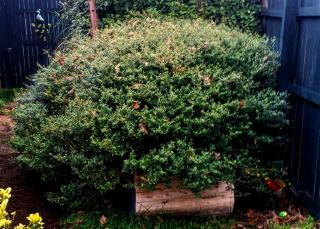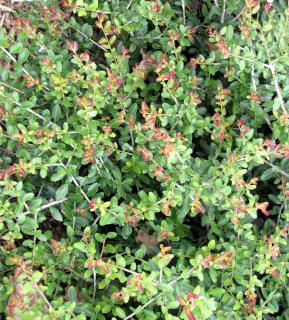

Dwarf yaupon holly is a special variety of yaupon. Its leaves aren’t as prickly as other holly bush varieties, and its berries are sometimes ever more luminous!
Name – Ilex vomitoria
Family – Ilex (holly family)
Type – evergreen
Exposure – full sun (part ok)
Height – up to 4 feet (125 cm)
Soil – any type
Planting dwarf yaupon holly in your garden is a guaranteed success for years of enjoyment!
Dwarf yaupon holly will usually survive being planted in almost any season, as long as it isn’t freezing or searing hot.
Read our guidelines on planting shrubs to get your planting right.
It’s also possible to grow dwarf yaupon holly in a pot or container. This is perfect for growing on a balcony. Simply use regular soil mix and check that the pot drains well (prevent water from collecting in a saucer under the pot).
Dwarf yaupon holly grows slowly but regularly.

During this time, if left unpruned, a dwarf yaupon holly shrub will keep growing at a rate of about 3 to 5 inches in width every year (7.5 to 12.5 cm), slightly less in height. This depends on growing conditions, of course. There are dwarf yaupon holly shrubs that are over 10 feet wide. Theoretically they can even grow to reach the size of non-dwarf varieties. This would be about 20 or even 30 feet wide and tall! However, such specimens are rare.
If you want to reduce the size of your dwarf yaupon holly, you should know that it can cope fairly well with severe pruning. New shoots will take off from the trunk and major branches. This is called hat racking, and should be reserved for holly and yaupon and boxwood but not much else.
If planted in the ground, you’ll only need to water your dwarf yaupon holly at the beginning. It’ll need about a year to spread its roots out and settle in.
Fertilizer isn’t needed for your yaupon holly to bloom, produce berries or grow leaves. If you do fertilize, try to limit the amount of nitrogen contained in the fertilizer. If there’s too much, it might burn the shrub rootlets.
Dwarf yaupon holly is not vulnerable to any of the most common diseases: sooty mold, downy mildew, etc.
Pests such as aphids will only briefly set down on your dwarf yaupon holly, before lifting off to more favorable plants (like nasturtium).
This shrub is a dioecious plant. This means each yaupon holly is either male or female. Male plants provide pollen and female plants provide eggs. This all happens in the flowers, which look different depending on the sex.
Most dwarf yaupon holly on the market for landscaping are clones. They were reproduced through cuttings and each is identical to the next. Only female specimens can bear berries, and they will only do so if a male specimen is planted nearby.
Typically, the dwarf yaupon holly variety found in garden stores is Ilex vomitoria ‘Nana’. However, there are a few other noteworthy dwarf yaupon holly species, listed here:

It will constantly offer green leaves for show, even in the middle of winter. These are excellent for making tea! Usually, they’re roasted in an oven until they turn a rich brown color. Air-dry them beforehand for about a week, first.
Female specimens boast cute red berries from November to February, and will feed birds in winter, too. Don’t eat them or you’ll trigger throwing up. Leave them for the birds.
Although not strictly a heath plant, dwarf yaupon holly tolerates acidic soil. This is a valuable option when setting up a heath plant flower bed together with heather, camellia, wonderful Japanese maple and more!
Read also:
You can even grow dwarf yaupon holly in your beach house or along the coast, because it can cope with high levels of salt!